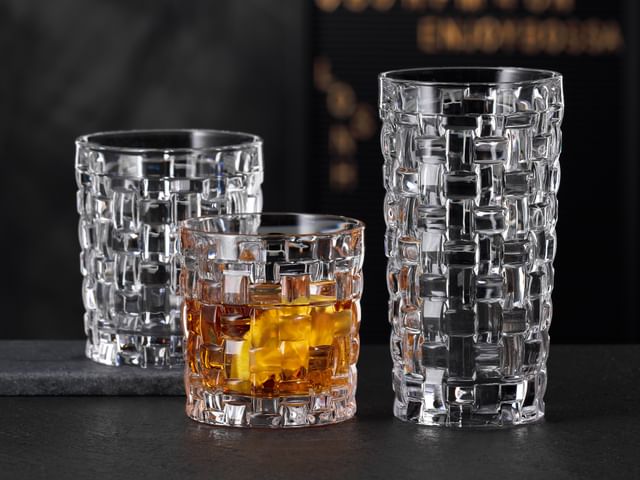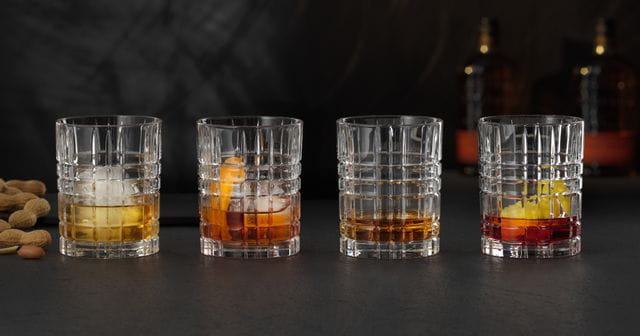Whiskey styles explained
A background to bourbon

As the whiskey style of some of the world's best-known spirits brands, bourbon is well-established as a force in the beverage world. Discover how this beloved whiskey style is made, its history, and some serving suggestions to help you get the most out of your favorite bourbon.

What is bourbon?
In the simplest terms, bourbon is a type of whiskey as it is produced by distilling fermented grains. But while all bourbon is whiskey, not all whiskey is bourbon, as there are specific distillation requirements that need to be followed for something to be classified as bourbon, namely:
- It must be produced in the United States. Kentucky produces more bourbon than any other state, but it can be made anywhere in the country. Any 'bourbon' produced outside the USA will be labeled as 'corn whiskey' or 'whiskey.'
- The mash bill must contain at least 51% corn.
- It must be no more than 160 proof 80% alcohol by volume (ABV) after distillation, 125 proof/62.5% ABV when barrelled, and no less than 80 proof/40% ABV when bottled.
- It must be aged in new, charred oak barrels.
Notable bourbon qualities and characteristics
Being aged in new, charred oak barrels gives bourbon its signature sweet, vanilla, and oaky flavor profile. The more time the bourbon spends aging in the barrel, the more oak flavor it will retain.
Another factor that affects the flavor of the bourbon is the temperature at which it is stored. Bourbon barrels are typically stored in multi-story warehouses, where upper floors are warmer than lower ones. Bourbon in barrels stored on the warmer upper floors often ends up drier and with more prominent spice notes, while bourbon stored on cooler floors undergoes a slower, more mellow aging process.
Bourbon's high corn content and charred oak-barrelled aging give it a rich, smooth, creamy, oily texture. Though different bourbons vary in richness, bourbon is usually more viscous than other whiskies such as scotch, Irish whiskey, and Canadian whisky, which are often made from more neutral grains, age in cooler temperatures, and may undergo different distillation processes.
The history of bourbon
Bourbon's origins
Bourbon originated in Kentucky, US, during the 1700s. Whiskey-making has been brought over to North America by European migrants - particularly Scottish and Irish settlers, and gradually developed in Kentucky into a distinct style.
The name 'bourbon' pre-dates the formal establishment of Bourbon County, possibly being named after Bourbon Street in New Orleans, which had developed a reputation for selling the whiskey and was itself named after the French Bourbon Dynasty. That said, while bourbon may not have been named after Bourbon County in Kentucky, the state played a key role in making bourbon into the distinctive style it is today. Kentucky's land was ideal for growing corn, bourbon whiskey's key grain, which set it apart from European whiskies that were often barley-dominant. Kentucky's limestone-rich water was also suitable for the distillation processes as it was more effective at filtering out impurities, making bourbon production all the more successful. So, while bourbon can be made anywhere in the US, Kentucky is undeniably the state with which it shares the deepest connection.
In 1964, the US Congress officially declared bourbon "America's Native Spirit," meaning it must be made in the United States, with strict guidelines on ingredients and aging, plus the requirement that bourbon be aged in new, charred oak barrels to impart bourbon's signature caramel and vanilla flavors.
Bourbon's popularity today
Despite experiencing fluctuations in popularity over the years, bourbon remains among the most prominent spirits in the present day as one of the leading spirits by sales volume and is a key ingredient in some classic cocktails.
In 2022, whiskey became the leading spirit category by sales volume in the US (97% of whiskey production being bourbon), surpassing vodka for the first time. Kentucky remains the premier production area of bourbon, with Tennessee a close second. Other bourbon-producing states include Indiana and Pennsylvania, plus western states that have developed a more recent role in whiskey production. There are now over 2,000 whiskey distilleries in the USA, ranging from huge brands like Jim Beam and Maker's Mark to small, independent distilleries.

Bourbon serving suggestions
Ways to serve your bourbon
Bourbon's sweet, charred notes make it a versatile spirit that can be enjoyed in several ways to please a range of preferences. If you're drinking bourbon from a rocks glass, such as one of our Nachtmann whisky tumblers, you can enjoy it neat, on the rocks, with a splash of water, or in a spirit-forward cocktail, such as an old fashioned, a mint julep, a whiskey sour, or a boulevardier. If you're using one of our Nachtmann long drink glasses, you can indulge in various bourbon-based highball cocktails. A classic bourbon highball adds soda water and citrus to the bourbon base; a ginger highball tops a single or double measure of bourbon with ginger beer for a highball cocktail with a kick, while a long old fashioned adds soda to a traditional old fashioned recipe.
Other ways of enjoying your bourbon include spirit-forward cocktails served without ice, such as a Manhattan, that are best sipped from a coupe glass like our Nachtmann Noblesse Cocktail Glass, or in warm alcoholic drinks like the hot toddy, which can be sipped comfortingly from our Nachtmann Ethno Barista Hot Beverage Glass.
Bourbon food pairings
When sipping bourbon alongside food, we recommend something that will harmonize with bourbon's distinctive character. We have a few suggestions we think you'll love:
- If you're sipping bourbon alongside a full meal, look towards classic southern US dishes such as barbecued and smoked meats, or fried chicken dishes. Bourbon's sweetness balances the smoky, spicy flavors in a brisket or burger, while it complements fried chicken's crisp, oily complexion.
- If you're enjoying a savory snack, consider pairing your bourbon with a mature cheese like an aged cheddar or gouda, the strength of which can enhance bourbon's notes of spices and caramel.
- When enjoying desserts with bourbon, robust dark chocolate-based dishes can stand up to the bourbon's intensity and contrast with its caramel and vanilla flavors.
- Other desserts that pair well with bourbon are ones that display caramelized, nutty, or spiced fruit flavors, such as pecan pie (a classic southern dish), apple cobbler, or salted caramel dishes.

From its 17th-century beginnings, bourbon has become the most recognizable US spirit and one of the most popular spirits worldwide. For information on other whiskey styles, see our blog 'Identify the whiskey style for you.'
Locations